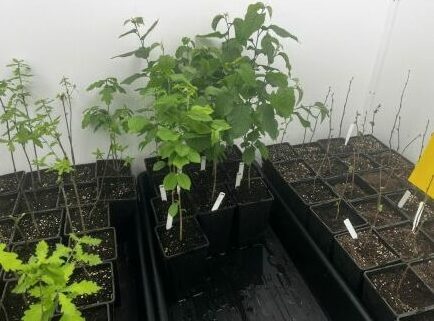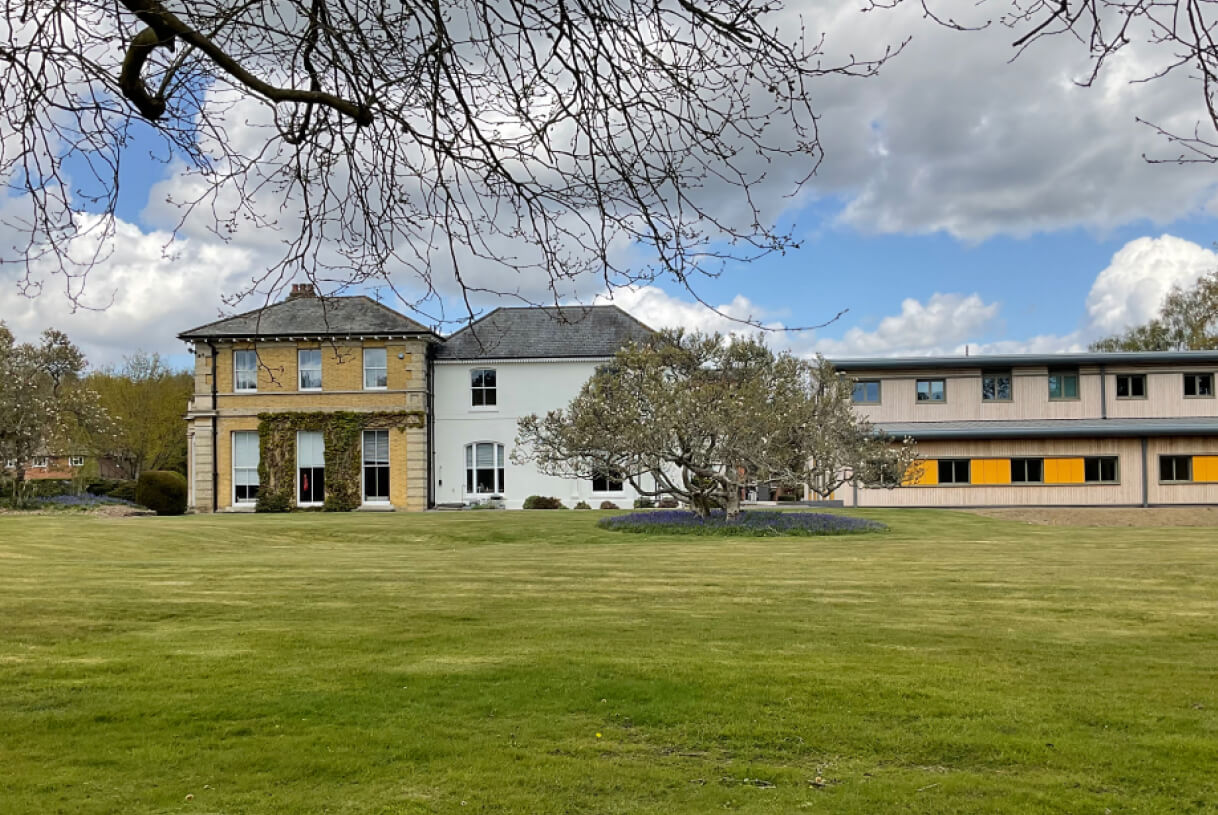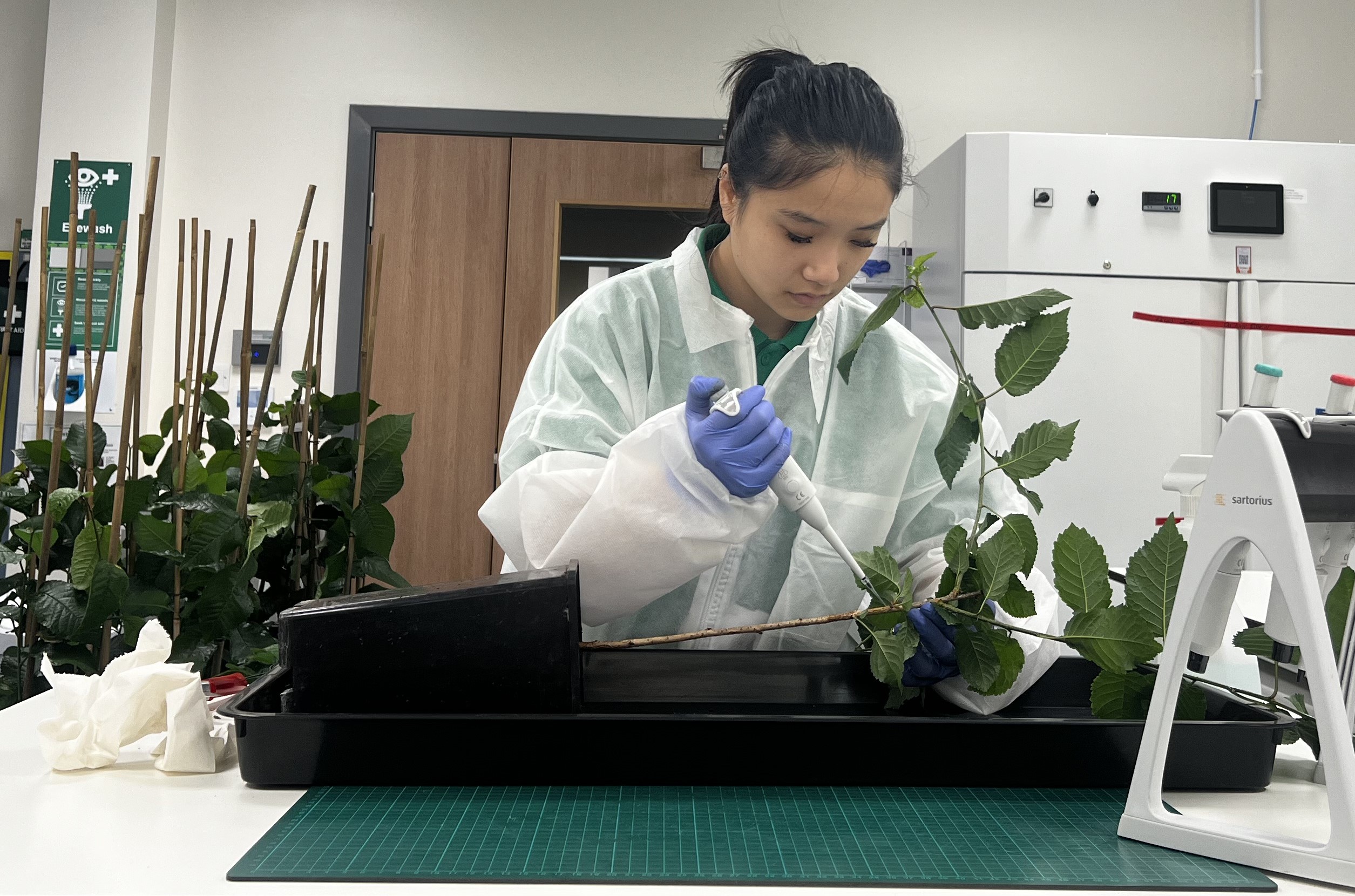Louise Gathercole and Jiaqi Wei
Our Coordinator caught up with Centre for Forest Protection PhD student Jiaqi Wei, who is working on the potential threats to UK trees of Xylella bacterial infections.
How did you become interested in plant health?
In London, I grew up amongst tall buildings and busy traffic, but my interest in the environment started at an early age. I loved watching Sir David Attenborough’s nature documentaries. The thing I found most eye-opening was all the beautiful and interesting plants, including carnivorous species and giant trees. The programmes also showed the harsh reality that if we don’t protect our wonderful world, we will lose it. Plant health is important to protecting our planet, including stopping the spread of diseases into new areas.

Tobacco plant (Nicotiana benthamiana) displaying ‘marginal leaf scorch’ – yellowing at the edges. A typical symptom of Xylella infection
What were you doing before you started your PhD, and what research methods had you learnt about?
I studied a BSc in Environmental Science at the University of Birmingham. I had the chance to do ecology field work, study plant sciences and learn coding using the R programming language.
What made you want to do this PhD and how did you apply for it?
For my undergraduate dissertation, I had been involved in the Birmingham Institute of Forest Research (BIFoR), which conducts state of the art research in plants, trees and climate change science and I wanted to continue working in this area. I applied directly for the PhD after finding the Centre for Forest Protection project on the Birmingham university portal.

Preparation of trees in the growth chamber, ready for inoculation with Xylella bacteria
Your project is a partnership between the Centre for Forest Protection at Forest Research, and BIFoR at Birmingham. What is it like working with two institutions, and where are you based?
My project is based both at BIFoR in Birmingham and at Forest Research near Farnham. I really like working on a project that is a partnership. I get to work in multiple places and have exposure to different people and environments. It is really great that I can experience both academia and industry. I have also had the chance to do some training with Xylella expert Blanca Landa and her team at CSIC-IAS in Spain and work with collaborators at Fera Science. For some of my PhD, I work in the Holt Laboratory at Forest Research. This is a quarantine lab, so I have had the chance to be trained in quarantine procedures. This has given me the chance to widen my skills and will help to increase my future employability.

The Wolfson glasshouses at Birmingham University
Can you tell me about Xylella – What is it?
Xylella fastidiosa (Xylella), endemic to Central America, is a bacterium that lives in the xylem (the water transport system) of some trees, shrubs and other plants. It doesn’t have a specific host so it can live on lots of different species. In the UK it is a quarantine bacterium, as it has not been found here yet, which is why I have to use the new quarantine lab to work on it.

Forest Research laboratories
What impacts is Xylella having in other countries?
The main impact has been the devastation of crop trees. Xylella is the causal agent for Piece disease, coffee leaf scorch, almond leaf scorch, phony peach disease, plum leaf scald, citrus variegated chlorosis disease and quick olive decline syndrome. These diseases can lead to huge losses in revenue each year affecting people’s livelihoods. In the olive orchards of Italy, it is also impacting on the local culture.
Why is Xylella a worry for the UK?
Xylella is a threat to agricultural fruit producing trees, but it can also potentially be a threat to forest trees, urban street trees and also native trees in UK woodlands. This would be a threat to our ecological and physical environments and to the timber industry. Most research is focused on fruit trees, so there is a large knowledge gap when it comes to woodland trees. If there was a Xylella outbreak in the UK, we currently don’t know which trees it would infect, or the extent of the risk of spread and infection in some species.

Xylella fastidiosa (subspecies fastidiosa) growing in a laboratory plate
Tell me about your project – what are you doing and what do you hope to find out?
I am conducting experiments on how different subspecies of Xylella can infect different UK native tree species. I will be infecting three different tree species: oak, wild cherry, and hazel with 4 different strains of Xylella. I would like to find out if the strains can establish in the UK trees and how the different strains affect the trees. I will also be looking at how each tree is responding to the infection and hope to find susceptible or resistant species.

Jiaqi inoculating cherry trees with the Xylella bacteria
What are the biggest challenges in your project?
Xylella is known for being notoriously difficult to work with as it is slow, and difficult to grow in the lab. Not many people work with this pathogen, so I have had to do a lot of foundation preparation to be able to work with it. For example, I have set up the laboratory protocols and run initial experiments that nobody has done in the UK before. I obtained the quarantine pathogen licenses, which was quite complicated and time consuming.
What do you find most satisfying?
Doing something that is new, and that not even my supervisors have done, is very challenging, but it is also the most satisfying part. I enjoy seeing everything coming together and now I am starting to see progress in my experiments.

Cherry (Prunus avium) inoculated with Xylella
Do you have any messages for readers about how they can help prevent Xylella coming to the UK?
Everyone can contribute to biosecurity. My message about Xylella is not to bring plants or plant materials into the UK. You can’t tell if a plant is infected with Xylella just by looking at it as they may not show symptoms for many years after infection, so it is best not to risk it!
You can find more information about Jiaqi’s project here.
To find out more about the actions you can take to keep plants in the UK healthy, head over to the Plant Health Action website.




